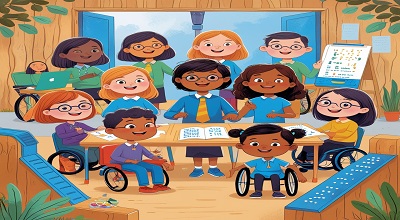Educational Support for Children
Educational Support for Children: Education is a fundamental right for every child, including those with disabilities. However, children with disabilities often face unique challenges that require specialized support to ensure they receive an equitable and quality education. This article explores the latest educational support strategies, legal frameworks, real-world examples, and emerging trends in disability education.
Understanding Disabilities in Education
Types of Disabilities
Children with disabilities may have:
- Learning Disabilities (e.g., dyslexia, dyscalculia)
- Physical Disabilities (e.g., cerebral palsy, muscular dystrophy)
- Sensory Disabilities (e.g., blindness, deafness)
- Intellectual Disabilities (e.g., Down syndrome)
- Autism Spectrum Disorder (ASD)
- Emotional and Behavioral Disorders (e.g., ADHD, anxiety disorders)
Challenges Faced by Children with Disabilities
- Lack of accessibility in schools
- Social stigma and bullying
- Insufficient teacher training
- Limited access to assistive technology
Legal Frameworks and Policies Supporting Inclusive Education
Individuals with Disabilities Education Act (IDEA)
IDEA ensures free and appropriate public education (FAPE) for children with disabilities in the U.S., mandating IEPs and least restrictive environments (LRE).
The Americans with Disabilities Act (ADA)
ADA prohibits discrimination and ensures accessibility in schools, including accommodations like ramps, sign language interpreters, and Braille materials.
United Nations Convention on the Rights of Persons with Disabilities (CRPD)
CRPD advocates for inclusive education globally, emphasizing equal opportunities for children with disabilities.
Educational Support Strategies for Children with Disabilities
Individualized Education Programs (IEPs)
An IEP is a customized plan outlining specific learning goals, accommodations, and services for a child with disabilities.
504 Plans
Unlike IEPs, 504 Plans provide accommodations (e.g., extended test time, preferential seating) without specialized instruction.
Universal Design for Learning (UDL)
UDL promotes flexible learning environments that accommodate diverse learning needs through multiple means of engagement, representation, and expression.
Assistive Technology in Education
Examples include:
- Screen readers for visually impaired students
- Speech-to-text software for students with dyslexia
- Adaptive keyboards for students with motor disabilities
Inclusive Classroom Practices
- Peer tutoring
- Differentiated instruction
- Cooperative learning groups
Examples of Effective Educational Support Programs
Case Study 1: Successful IEP Implementation
A 10-year-old with autism thrived in a mainstream classroom with an IEP that included sensory breaks, visual schedules, and a dedicated aide.
Case Study 2: Assistive Technology in Action
A deaf student used a real-time captioning app to follow lectures, improving participation and academic performance.
Case Study 3: Inclusive Schools Making a Difference
A school in Sweden implemented UDL principles, resulting in higher engagement and achievement for all students, including those with disabilities.
The Role of Teachers and Parents in Supporting Children with Disabilities
Teacher Training and Professional Development
Ongoing training in special education strategies is crucial for effective inclusion.
Parental Involvement and Advocacy
Parents play a key role in IEP meetings, ensuring their child’s needs are met.
Latest Trends and Innovations in Disability Education
AI and Machine Learning for Personalized Learning
AI-driven platforms adapt lessons in real-time based on student performance.
Virtual Reality (VR) for Sensory Disabilities
VR helps visually impaired students navigate virtual environments safely.
Gamification in Special Education
Educational games improve engagement and learning outcomes for children with ADHD and ASD.
Challenges and Future Directions
Barriers to Inclusive Education
- Funding shortages
- Lack of trained educators
- Societal attitudes
The Future of Disability Education
Increased use of AI, global policy improvements, and stronger advocacy will shape inclusive education.
Conclusion
Educational support for children with disabilities is evolving with innovative strategies, legal protections, and technology. Collaboration among educators, parents, and policymakers is essential for creating inclusive learning environments.
FAQs
1. What is the difference between an IEP and a 504 Plan?
An IEP provides specialized instruction and services, while a 504 Plan offers accommodations without altering curriculum.
2. How can teachers support students with autism in the classroom?
Strategies include visual schedules, sensory breaks, and structured routines.
3. What are some examples of assistive technology for students with disabilities?
Screen readers, speech-to-text software, and adaptive keyboards are common tools.
4. How does Universal Design for Learning (UDL) benefit all students?
UDL provides multiple ways to engage, represent, and express learning, benefiting diverse learners.
5. What role do parents play in their child’s special education?
Parents advocate for their child’s needs, participate in IEP meetings, and collaborate with educators.
Free Download: Best Memrise Language APP
